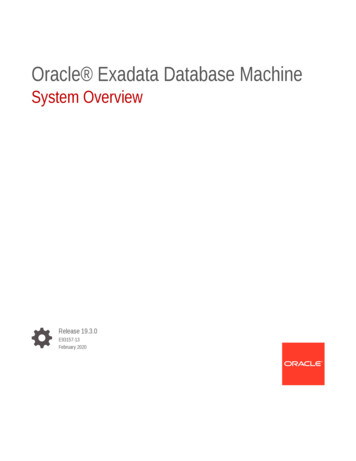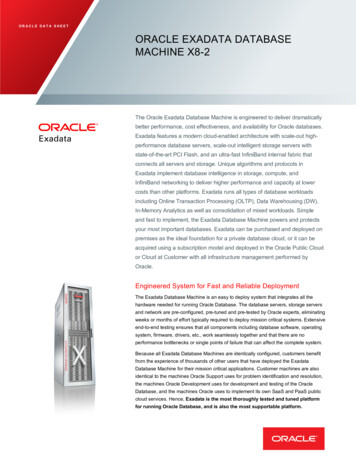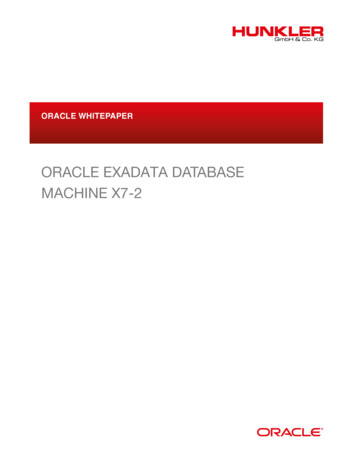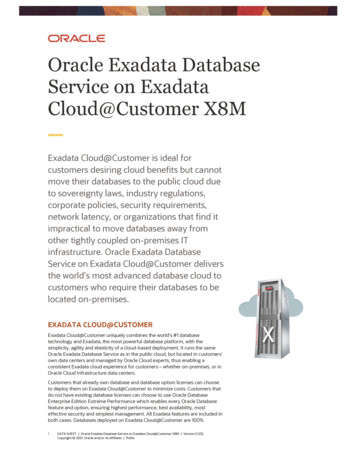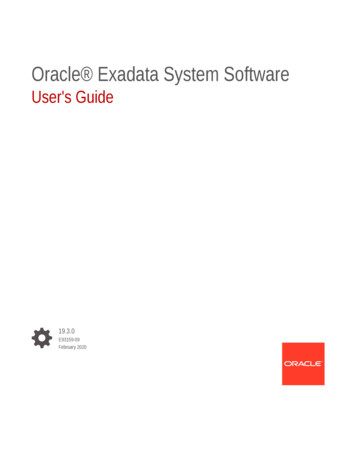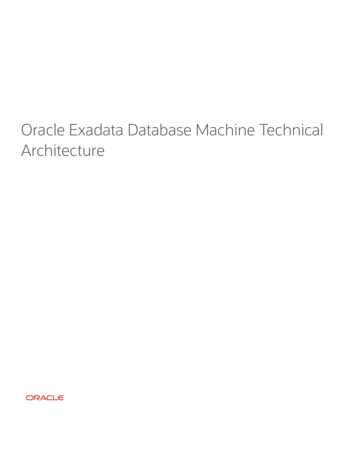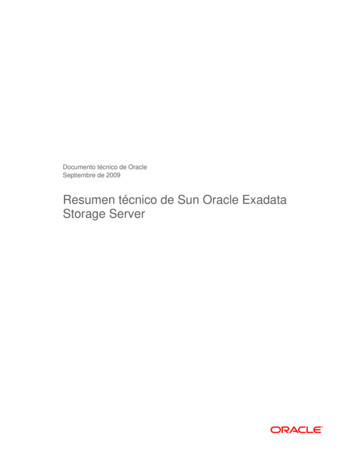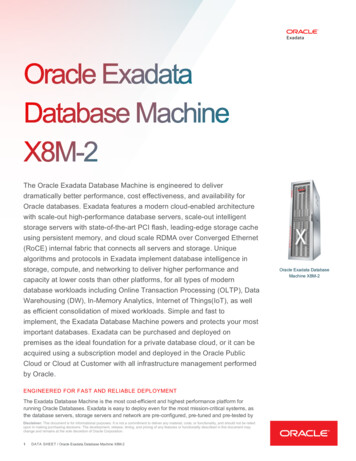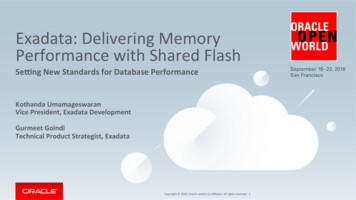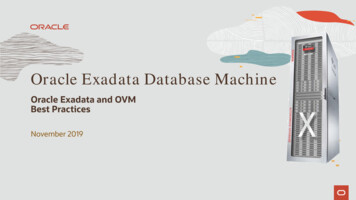
Transcription
Oracle Exadata Database MachineOracle Exadata and OVMBest PracticesNovember 2019
Topics Covered Use Cases Exadata OVM Software Requirements Exadata Isolation Considerations Exadata OVM Sizing and Prerequisites Exadata OVM Deployment Overview Exadata OVM Administration and Operational Life Cycle Migration, HA, Backup/Restore, Upgrading/Patching Monitoring, Resource ManagementCopyright 2019 Oracle and/or its affiliates.2
Exadata Virtual MachinesHigh-Performance Virtualized Database Platform XEN hypervisorFINANCENo Additional CostX8-2, X7-2, X6-2, X5-2,X4-2, X3-2, X2-2SALES Hosting, cloud, cross department consolidation,test/dev,non-database or third party applications Exadata VMs deliver near raw hardware performance I/Os go directly to high-speed InfiniBand bypassinghypervisorDB 11.2 and higherSUPPLYCHAINCopyright 2019 Oracle and/or its affiliates. VMs provide CPU, memory, OS, and sysadmin isolationfor consolidated workloads Combine with Exadata network and I/Oprioritization to achieve unique full stack isolation Trusted Partitions allow licensing by virtualmachine3
Exadata Consolidation Options VMs have good Isolation but poor efficiencyand high management VMs have separate OS, memory, CPUs, andpatching Isolation without need to trust DBA, System AdminMany DBs inone ServerDatabaseMultitenantCopyright 2019 Oracle and/or its affiliates.VMVMMore EfficientVirtualMachinesVMMore IsolationDedicatedDB Servers Database consolidation in a single OS is highlyefficient but less isolated DB Resource manager isolation adds no overhead Resources can be shared much more dynamically But, must trust admins to configure systemscorrectly Best strategy is to combine VMs with databasenative consolidation Multiple trusted DBs or Pluggable DBs in a VM Few VMs per server to limit overhead offragmenting CPUs/memory/patching etc.4
Software Architecture ComparisonDatabase Server: Bare Metal / Physical versus OVMBare Metal /PhysicalDatabase ServerOracle GI/DB homesExadata (Linux,firmware)OVM Database Serverdom0Exadata (Linux,Xen, fireware)domU-3Oracle GI/DBdomU-2homesOracleExadataGI/DB (Linux)domU-1homesOracleExadataGI/DB (Linux)homesExadata (Linux)No change to Storage Grid, Networking, or OtherCopyright 2019 Oracle and/or its affiliates.5
Differences Between Physical and OVMDetails expanded throughout remaining slidesTopicHow OVM differs from PhysicalHardware support2-socket onlyCluster configSystem has one or more VM clusters, each with own GI/RAC/DB installExadata storageconfigSeparate griddisks/DATA/RECO for each VM cluster; By default no DBFS diskgroupDbnode disk configVM filesystem sizes are small; GI/DB separate filesystemsSoftware updatesDbnodes require separate dom0 (Linux firmware) and domU (Linux) patchmgrupdatesExachkRun once for dom0/cells/ibswitches, run once for each VM clusterEnterprise ManagerEM Exadata plugin Virtualization Infrastructure pluginCopyright 2019 Oracle and/or its affiliates.6
Exadata VM Usage Primary focused on consolidation and isolation Can only run certified Oracle Linux versions Windows, RedHat, and other guest operating systems are not supported Can virtualize other lightweight products E.g. Lightweight apps, management tools, ETL tools, security tools, etc. Not recommended for heavyweight applications E.g. E-business Suite or SAP application tier Instead use Private Cloud ApplianceCopyright 2019 Oracle and/or its affiliates.7
Exadata OVM Requirements Hardware 2-socket database servers supported (X2-2 through X8-2) Software Recommend latest Exadata 18.x or 19.x software Supplied software (update with patchmgr - see MOS 888828.1) domU and dom0 run same UEK kernel as physical domU runs same Oracle Linux (OL) as physical dom0 runs Oracle VM Server (OVS) 3.x Grid Infrastructure / Database Recommend 19c with latest quarterly update Supported 19c, 18c, 12.2.0.1, 12.1.0.2, or 11.2.0.4Copyright 2019 Oracle and/or its affiliates.8
Exadata Security Isolation Recommendations Each VM RAC cluster has its own Exadata grid disks and ASM DiskGroups Setting Up Oracle ASM-Scoped Security on Oracle Exadata Storage Servers 802.1Q VLAN Tagging for Client and Management EthernetNetworks Dbnodes configured w/ OEDA during deployment (requires pre-deploymentswitch config) Or configure manually post-deployment Client network - MOS 2018550.1Management network - MOS 2090345.1 InfiniBand Partitioning with PKEYs for Exadata Private Network OS and InfiniBand switches configured w/ OEDA during deployment Storage Server administration isolation through ExaCLICopyright 2019 Oracle and/or its affiliates.9
Exadata OVM Sizing RecommendationsUse Reference Architecture Sizing Tool to determine CPUs, memory,disk space needed by each database Sizing evaluation should be done prior to deployment since OEDA willdeploy your desired VM configuration in an automated and simple manner. Changes can be made post deployment, but requires many more steps Sizing approach does not really change except for accommodating DOM0,and additional system resources per VM Sizing tool currently does not size virtual systems Consider dom0 memory and CPU usage in sizingCopyright 2019 Oracle and/or its affiliates.10
Memory Sizing Recommendations Can not over-provision physical memory Sum of all VMs dom0 memory used cannot exceed physical memory Sum of all VM memory 720 GB X8, X7, X6 database servers support maximum 768 GB physical memory whendeployed virtualized (non-virtualized systems support higher) dom0 memory sizing 8 GB (do not change unless directed by Oracle) VM memory sizing Initially set during OEDA configurationMinimum 16 GB per VM (to support OS, GI/ASM, starter DB, few connections)Maximum 720 GB for single VMMemory size on Exadata can not be changed online (VM restart required)Copyright 2019 Oracle and/or its affiliates.11
CPU Sizing Recommendations CPU over-provisioning is possible But workload performance conflicts can arise if all VMs become fully active Dom0 CPU sizing Allocated 2 cores (4 vCPUs - do not change unless directed by Oracle) VM CPU sizing Minimum per VM is 2 cores (4 vCPUs) 1 vCPU 1 hyper-thread; 1 core 2 hyper-threads 2 vCPUs Maximum per VM per DB Server is number of cores minus 2 for dom0 E.g.: for X8-2, maximum per VM per DB Server is 46 cores (48 total minus 2 for dom0) vCPU initially set during OEDA configuration vCPU can be changed dynamically (online while VM remains up)Copyright 2019 Oracle and/or its affiliates.12
Local Disk Sizing Recommendations Total local disk space available for VMs X8 - 3.2TB; X7,X6,X5 - 1.6TB, 3.7TB with disk drive expansion kit; X4 - 1.6TB 190GB used per VM at deployment, extendable post-deployment Actual allocated space for domU disk images initially much lower due to sparsenessand shareable reflinks, but will grow with domU use as shared space diverges andbecomes less sparse Over-provisioning disk may cause unpredictable out-of-space errors inside VMs if dom0 space is exhaustedRestoring VM backup will reduce (may eliminate) space savings (i.e. relying on over-provisioning may prevent full VMrestore)Long lived / prod VMs should budget for full space allocation (assume no benefit from sparseness and shareablereflinks)Short lived test/dev VMs can assume 100 GB allocation DomU local space can be extended after initial deployment by adding local disk images Additionally, domU space can be extended with shared storage (e.g. ACFS, DBFS, external NFS) for user / app filesAvoid shared storage for Oracle/Linux binaries/config files. Access/network issues may cause system crash or hang.Copyright 2019 Oracle and/or its affiliates.13
Exadata Storage Recommendation DATA/RECO size for initial VM clusters should consider future VM additions Using all space initially will require shrinking existing DATA/RECO before adding new Spread DATA/RECO for each VM cluster across all disks on all cells By default no DBFS disk group Enable ASM-Scoped Security to limit grid disk accessVMClusterClusternodesGrid disks (DATA/RECO for all clusters on all disks inall cells)clu1db01vm01db02vm01DATAC1 CD {00.11} cel01 RECOC1 CD {00.11} cel01DATAC1 CD {00.11} cel02 RECOC1 CD {00.11} cel02DATAC1 CD {00.11} cel03 RECOC1 CD {00.11} cel03clu2db01vm02db02vm02DATAC2 CD {00.11} cel01 RECOC2 CD {00.11} cel01DATAC2 CD {00.11} cel02 RECOC2 CD {00.11} cel02DATAC2 CD {00.11} cel03 RECOC2 CD {00.11} cel03Copyright 2019 Oracle and/or its affiliates.14
Deployment Specifications and LimitsMemory VMsHardwareX4-2Physical per database server (default/max)256 GB512 GB256 GB512 GB256 GB768 GBMin per VMX7-2X8-2256 GB768 GB2384 GB768 GB216 GBMax per VM464 GB720 GBDefault settingInitially set during OEDA configuration1624Min cores/vCPU per VM3644482 core (4 vCPUs)Max cores/vCPU per VMTotal usable disk per dbserver for all VMsX6-28Cores minus 2 (dom0 assigned 2 cores/4vCPUs)Default settingDiskX5-2Max VMs per database serverCores/vCPU1 per database serverCPUX3-2Initially set during OEDA configuration700 GB1.6 TB1.6 TB (3.7 TB w/ DB Storage Expansion Kit)3.2 TB190 GBUsed disk per VM at deploymentActual allocated space for domU disk images initially much lower due to sparseness and shareablereflinks, but will grow with domU use as shared space diverges and becomes less sparse, hencebudget for these values when sizing.Footnotes: 1) 1 core 1 OCPU 2 hyper-threads 2 vCPUs; 2) Systems deployed non-virtual support higher physical memoryCopyright 2019 Oracle and/or its affiliates.15
Deployment OverviewOEDA is the only tool that should be used to create VMs on Exadata1. Create configuration with OEDA Configuration Tool2. Prepare customer environment for OEDA deploymentConfigure DNS, configure switches for VLANs (if necessary)3. Prepare Exadata system for OEDA deploymentswitch to ovm.sh; reclaimdisks.sh; applyElasticConfig.sh4. Deploy system with OEDA Deployment ToolNote: OS VLAN config can be done by OEDA or post deployment (MOS2018550.1)Copyright 2019 Oracle and/or its affiliates.16
OEDA Configuration ToolConfiguring OVM Screen to decide OVM orPhysical All OVM All Physical Some OVM, some physicalCopyright 2019 Oracle and/or its affiliates.17
OEDA Configuration ToolDefine Clusters Decide Number of VM clusters tocreate Dbnodes and Cells that willmake up those VM clusters Recommend using all cells What is a “VM cluster?” 1 or more user domains ondifferent database serversrunning Oracle GI/RAC, eachaccessing the same sharedExadata storage managed byASM.Copyright 2019 Oracle and/or its affiliates.18
OEDA Configuration ToolCluster ConfigurationEach VM cluster has its own configuration VM size (memory, CPU)Exadata software versionNetworking configOS users and groupsGI/DB version and locationStarter database configASM disk group configCopyright 2019 Oracle and/or its affiliates.19
OEDA Configuration ToolCluster ConfigurationGrid infrastructure installed ineach VM (grid disks “owned”by a VM cluster) Cluster 1 - DATAC1 / RECOC1 acrossall cells Cluster 2 - DATAC2 / RECOC2across all cells Consider future clusters whensizing DBFS not configured ASM-Scoped Security permits acluster to access only its own griddisks. Available with Advancedbutton.Copyright 2019 Oracle and/or its affiliates.20
OEDA Configuration ToolCluster Advanced Network Configuration Ethernet VLAN ID and IP details To separate Ethernet traffic across VMs, usedistinct VLAN ID and IP info for each cluster Ethernet switches (customer and Cisco) musthave VLAN tag configuration done beforeOEDA deployment InfiniBand PKEY and IP details Typically just use OEDA defaults Compute Cluster network for dbnode-todbnode RAC traffic. Separates IB traffic byusing distinct Cluster PKEY and IP subnet foreach cluster. Storage network for dbnode-to-cell or cell-tocell traffic - same PKEY/subnet for all clustersCopyright 2019 Oracle and/or its affiliates.21
OEDA Configuration ToolInstallation TemplateVerify proper settingsfor all VM clusters inInstallation Templateso the environmentcan properlyconfigured beforedeployment (DNS,switches, VLANs, etc.).Copyright 2019 Oracle and/or its affiliates.22
OEDA Configuration ToolNetwork RequirementsComponentDatabase serversDomainNetworkExample hostnamedom0(one per databaseserver)Mgmt eth0dm01dbadm01Mgmt ILOMdm01dbadm01-ilomMgmt eth0dm01dbadm01vm01Client bondeth0dm01client01vm01Client VIPdm01client01vm01-vipClient SCANdm01vm01-scanPrivate ibdm01dbadm01vm01-priv1Mgmt eth0dm01celadm01Mgmt ILOMdm01celadm01-ilomPrivate ibdm01celadm01-priv1Mgmt eth0dm01sw-*domU(one or more perdatabase server)Storage servers (same as physical)Switches (same as physical)Copyright 2019 Oracle and/or its affiliates.23
Exadata OVM Basic MaintenanceRefer to Exadata Database Maintenance Guide: Managing Oracle VMDomains on Oracle Exadata Database Machine Show Running Domains, Monitoring, Startup, ShutdownDisabling User Domain Automatic StartModify Memory, CPU, local disk space in a user domainRemove/Create RAC VM ClusterExpand Oracle RAC VM clusterCreate User Domain without Grid Infrastructure (e.g. App VM)Moving a User Domain to a Different Database ServerDeleting a User Domain from an Oracle RAC VM ClusterRunning exachkCopyright 2019 Oracle and/or its affiliates.24
Exadata OVM Basic Maintenance Backing Up and Restoring Oracle Databases on Oracle VM User DomainsCreating Oracle VM Oracle RAC ClustersCreating Oracle VM without GI and Database for AppsAdd or Drop Oracle RAC nodes in Oracle VMExpanding /EXAVMIMAGES on User Domains after Database Server DiskExpansionImplementing Tagged VLAN InterfacesImplementing InfiniBand Partitioning across OVM RAC Clusters on OracleExadataBacking up the Management Domain (dom0) and User Domains (domU) inan Oracle Virtual Server DeploymentMigrating a Bare Metal Oracle RAC Cluster to an OVM RAC ClusterCopyright 2019 Oracle and/or its affiliates.25
OEDACLI to Perform Maintenance Operations OEDA Command Line Interface Orchestrate Exadata life cycle management tasks Supported post-deployment operations with VMs – Examples: Add/Remove VM clusterAdd/Remove nodeAdd/Remove databaseAdd/Remove database homeAdd/Remove storage cellResize ASM disk groupUpgrade ClusterwareCopyright 2019 Oracle and/or its affiliates.26
Exadata OVM Migration Dynamic or online method to change physical to virtual Data Guard or backups can be used to move databases – minimumdowntime Convert one node or subset of nodes to virtual at a time Migrating an existing physical Exadata rack to use virtual requires Backing up existing databases, redeploying existing HW with OEDA andthen Restoring Databases Duplicating the databases to existing Exadata OVM configuration If moving from source to a new target, standard Exadata migration practicesstill apply. Refer to Best Practices for Migrating to Exadata DatabaseMachineCopyright 2019 Oracle and/or its affiliates.27
Exadata OVM MigrationDynamic or online method to change physical to virtual using any ofthe procedures belowMigrate to OVM RAC cluster using the existing bare metal Oracle RAC cluster with zerodowntimeMigrate to OVM RAC cluster by creating a new OVM RAC cluster with minimal downtimeMigrate to OVM RAC cluster using Oracle Data Guard with minimal downtimeMigrate to OVM RAC cluster using RMAN backup and restore with complete downtimeFor requirements and detailed steps, refer to My Oracle Support note2099488.1: Migration of a Bare metal RAC cluster to an OVM RACcluster on ExadataCopyright 2019 Oracle and/or its affiliates.28
Backup/Restore of Virtualized Environment Dom0 Standard backup/restore practices to external locationDomU – Two Methods Backup within Dom0: Snapshot the VM image and backup snapshot externally Backup within DomU: Standard OS backup/restore practices apply If over-provisioning local disk space - Restoring VM backup will reduce (mayeliminate) space savings (i.e. relying on over-provisioning may prevent full VMrestore) Database backups/restore Use standard Exadata MAA practices with RMAN, ZDLRA, and Cloud StorageRefer to Exadata Database Machine Maintenance GuideCopyright 2019 Oracle and/or its affiliates.29
Updating SoftwareComponent toupdateMethodStorage serversSame as physical - run patchmgr from any server with ssh access to all cells, or useStorage Server Cloud Scale Software Update feature (starting in 18.1).InfiniBandswitchesSame as physical - run patchmgr from dom0 with ssh access to all switches.Database server– dom0Run patchmgr from any server with ssh access to all dom0s. Dom0 update upgradesdatabase server firmware. Dom0 reboot requires restart of all local domUs. DomUsoftware not updated during dom0 update. Dom0/domU do not have to run sameversion, although specific update ordering may be required (see 888828.1).Database server– domURun patchmgr from any server with ssh access to all domUs. Typically done on a perVM cluster basis (e.g. vm01 on all nodes, then vm02, etc.), or update all VMs on a serverbefore moving to next.GridInfrastructure /DatabaseStandard upgrade and patching methods apply, maintained on a per-VM cluster scope.GI/DB homes should be mounted disk images, like initial deployment. 12.2 upgradeMOS 2111010.1.Copyright 2019 Oracle and/or its affiliates.30
Health Checks and MonitoringExachk runs in Dom0 and DomU (cells and IB switches checks run withDom0)Run in one dom0 for all dom0s, cells, switchesRun in one domU of each VM cluster for all domUs, GI/DB of that clusterEM Monitoring support (MOS 1967701.1)Exawatcher runs in Dom0 and DomUDatabase/GI monitoring practices still applyConsiderationsDom0-specific utilities (xmtop)Dom0 is not sized to accommodate EM or custom agentsOracle VM Manager not supported on ExadataCopyright 2019 Oracle and/or its affiliates.31
EM Support for Exadata VirtualizationProvisioningVM provisioning onVirtualized Exadatainvolves reliable,automated, &scheduled massdeployment of RACCluster IncludesVMs/DB/GI/ASMCreate / delete RACCluster IncludingDB/GI/ASMScale up / down RACCluster by adding orremoving VMs IncludesDB/GI/ASMIncrease Operational Efficiency by Deploying RAC Cluster Faster on Virtualized ExadataCopyright 2019 Oracle and/or its affiliates.32
Exadata MAA/HA Exadata MAA failure/repair practices still applicable. Refer to MAABest Practices for Oracle Exadata Database Machine OVM Live Migration is not supported – use RAC to move workloadsbetween nodesCopyright 2019 Oracle and/or its affiliates.33
Resource Management Exadata Resource Management practices still apply Exadata IO and flash resource management are all applicable and useful Within VMs and within a cluster, database resource managementpractices still apply cpu count still needs to be set at the database instance level for multipledatabases in a VM. Recommended min 2 No local disk resource management and prioritization IO intensive workloads should not use local disks For higher IO performance and bandwidth, use ACFS or DBFS on Exadata orNFS.Copyright 2019 Oracle and/or its affiliates.34
Configure DNS, configure switches for VLANs (if necessary) 3. Prepare Exadata system for OEDA deployment switch_to_ovm.sh; reclaimdisks.sh; applyElasticConfig.sh. 4. Deploy system with OEDA Deployment Tool. Note: OS VLAN config can be done by OEDA or post deployment (MOS 2018550.1) OEDA is the only tool that should be used to create VMs on Exadata
